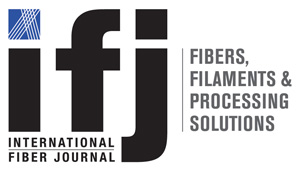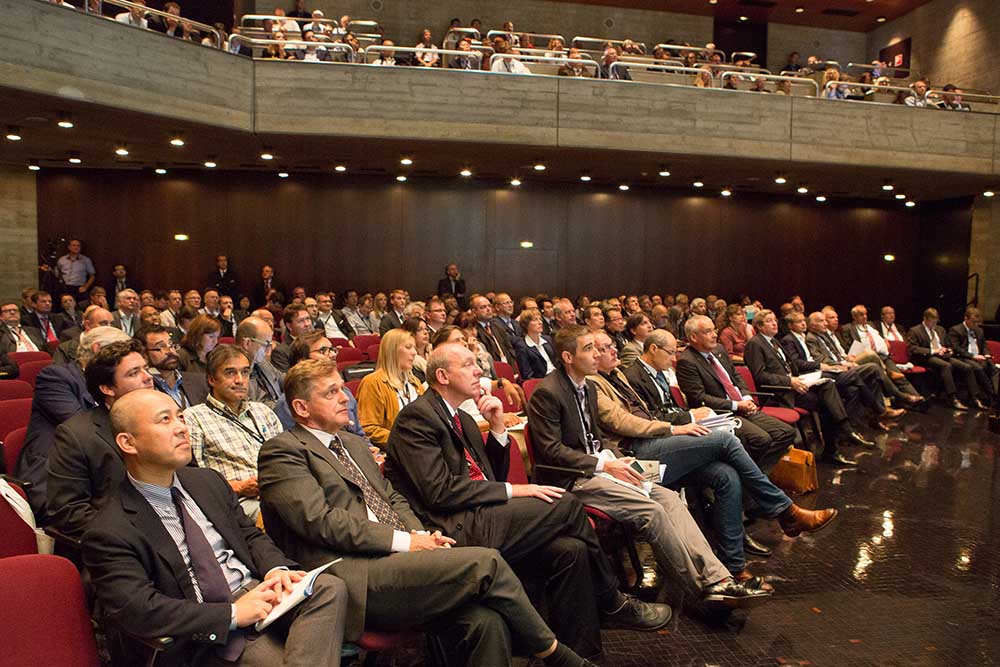This year’s Dornbirn Man-Made Fibers Congress attracted around 720 participants from 34 countries.
Innovation remains the “DNA” of the Dornbirn Man-Made Fibers Congress, which has taken place for the past 55 years in the city of Dornbirn in the Vorarlberg region of Austria.
This year’s event attracted around 720 participants from 34 countries and more than 100 lectures, with around 50% presented by industry companies such as Murata, Rieter, Saurer, Dornier and Groz-Beckert providing a new focus on textile machinery.
The main themes of the congress were: fiber innovations; fibers and textiles in automotive; fibers for nonwovens; finishing and functional additives; and textiles. However, like many other international events – and indeed this industry journal – this annual conference is moving inexorably towards the technical textiles and nonwovens sectors.
Following the co-operation with EDANA, the Brussels-based association for the nonwovens and related industries, the Dornbirn organization has now announced a partnership with trade fair organizer Messe Frankfurt, which holds the global Techtextil events for technical textiles and nonwovens, and also Avantex, the fair for high-tech materials and fabrics for clothing held twice a year in Paris.
This year EDANA organized a lecture block for the nonwovens segment at Dornbirn, while Dornbirn-MFC will organize a special lecture block for the next Techtextil fair in Frankfurt am Main, Germany, in May 2017.
Product specialization
Opening this year’s congress, Robert van de Kerkhof, president of the Austrian Man-Made Fibers Institute and chief operating officer of Lenzing, said the industry is currently operating in a reasonable business environment and is “back on track” with a global production growth of 4.8% in 2015 compared with the previous year.
However, the low oil price means that fibers are being sold on the market at very low prices, leading to a distortion of inter-fiber competition. “We should urgently consider whether it would make sense to reduce capacities for standard polyester fibers on a larger scale once instead of repeatedly increasing volumes,” he told the audience.
The poor price situation of polyester in particular is largely the result of huge capacities that have been built up in recent years. By contrast, demand for wood-based cellulosic fibers is high with a double-digit rise in selling prices this year, although the cotton industry is going through turbulent times with Chinese inventories being reduced.
“For the first time since 2010, viscose fiber prices have been higher than that of cotton for a long period,” van de Kerkhof noted. “As to carbon fibers, the strong demand has led to a substantial increase in prices, although against the backdrop of limited production capacities.”
He said there is a danger that excess production capacities for cellulose fibers and other products will arise as a consequence of the good price situation, leading to “commoditization” of high-quality products.
However, specialization “opens up many innovation opportunities for which the marketplace is prepared to pay a premium compared to standard fibers,” said van de Kerkhof, giving the example of innovative technical textiles for such end-uses as healthcare, agriculture, construction, automotive and environmental protection.
“Our goal must be to offer products made of renewable raw materials and fibers with the least possible environmental impact when they are processed along the value chain. Only then will we be able to achieve a fair premium in the future for such products.”
Intense competition
Frédéric Van Houte, director general of CIRFS, the European Man-made Fibres Association, said that while manufacturing in Europe is challenging, competition between various manmade fibers (and with natural fibers) is intense and will not decrease.
However, the market is growing with global fiber production at 95.9 million tons in 2015, and there are opportunities for companies that can meet the challenges of overcapacity, trade distortions, exchange rate volatility, volatile raw material prices, rising energy and labor costs, and increasing legislative burden.
Van Houte said meeting the sustainability challenge with sustainable innovation would be key, with every manufacturer needing to develop its own strategy for success.
Speed to market
Examining the development of global fiber markets, Uday Gill, CEO of Fibers of Indorama Ventures, noted that the road to market is long with most fibers in use today having been developed many decades ago.
“Meanwhile, the benefits of cost innovations are tapering off, with scale and efficiency now providing only nominal improvements,” he said. “Entry barriers are dropping, but innovation is not bringing anything new.
“While the U.S., Europe and Japan and investing in research and development, the capacity share is in China/Asia, where there is a limited interest in innovation.
Gill said the consequences of inadequate innovation are perpetual overcapacity and lower utilization rates.
“The industry needs innovation to decouple its dependence on fossil fuels – and I believe this is coming. This will change supply chains and business processes. “The future is going to change the game. The question is who will adapt?”
Gill believes strategic innovation, which utilizes artificial intelligence, robotics, biosynthesis and new materials, can bridge the gap between a supplier focus and consumer preferences, but this will mean looking beyond product and process innovation.
“The world has yet to fully exploit the potential of fibers, but we have to link the whole process in line with consumer demands,” he said, noting there will always be a conflict between R&D and business operations.
Gill explained that sustainable growth can be achieved by balancing the production of commodities and specialties to keep costs low and enhance margins.
“Speed to market is the key, but the industry has to collaborate, otherwise return on investment will be reduced,” he said.
Circular economy update
During the opening session, the European Commission provided an update on the circular economy action plan for Europe’s textile industry, announcing that it wants to offer more guidance to national authorities and research organizations to enhance the industry’s ongoing sustainability efforts.
The Commission’s Julio Cardoso outlined three main goals to help raise the profile of the circular economy in Europe: increased innovation and recycling rates, reduced landfill and incineration levels, and new investment in waste treatment facilities and recycling capacity.
Cardoso said that, despite post-consumer recycling still being in its infancy, the industry is becoming more aware of various take-back schemes, noting that 60% of textiles donated to these programs are reused as whole garments.
However, in terms of sustainability opportunities further down the supply chain, the EC wants to place a stronger focus on textile fibers being created from non-textile waste (such as PET bottles), from post-consumer textile waste (such as airbags and fishing nets), and from leftover clothing garments or surplus stock.
Paul Schlack prize
Dr. Nguyen Hoai An Tran of the Leibniz Institute of Polymer Research Dresden was awarded the Paul Schlack/Wilhelm Albrecht Prize 2016 for his work on “Melt spinning and characterization of biodegradable micro- and nanofibrillar from poly(latic acid) and (vinyl alcohol) blends”.

Fiber innovations
The production and use of carbon fibers was a key theme among the fiber innovations sessions. Peter Antoinette, chief executive officer of Nanocomp Technologies, described a new class of carbon-based materials called Miralon, which can be made into yarns as well as nonwoven sheets and tapes.
Initially developed for the spacecraft market, Miralon materials are composed of carbon tubes with a length of 1-10 mm and a diameter of 3-5 nm, which provide attractive macro-properties.
Antoinette explained that these are not traditional carbon nanotubes, but materials with macro-particle dimensions that are non-respirable and thus considered safe.
Miralon is a ductile carbon fiber that can be stitched onto commercial equipment. The all-carbon system offers resin compatibility, and the material has high tensile modulus, electrical conduction (sensing, heating, dissipation), high toughness and a low coefficient of thermal expansion.
The material can also be knitted into mesh structures or incorporated into traditional woven or knitted fabrics, as well as being used as reinforcement in composites. Antoinette revealed that NASA is constructing a Miralon composite overwrap propellant tank for flight test later this year.
Nanocomp currently has a pilot plant in in Merrimack, New Hampshire, USA, with a 1-ton annual capacity. The company is raising $25 million in equity capital to increase annual production to 8 tons by 2018 and a full capacity of 40 tons a year by 2020.
Ana-Paula Vidigal of Fisipe, which has been part of the SGL Group since 2012, remarked that the company has inaugurated a carbon fiber precursor production line at its site in Lavradio, near Lisbon, Portugal.
Meanwhile, Martin Kirsten of the Technische Universität Dresden described the development and production of polyacrylonitrile (PAN) precursor fibers for producing tailor-made carbon fibers.
A new hydrophilic fiber, hydrophilamide (HDM), was introduced by joint developers Invista and Golden Lady. Branded as Nerino G, the fiber combines the “exceptional” characteristics of synthetic fibers with the unique properties of natural fibers. The Italian company is already selling the new yarn for sportswear, intimate wear, shirts, bed sheets and bathrobes.
Sportswear giant Adidas launched its Futurecraft MFG running shoes from its first automated Speed Factory facility in Ansbach, Germany. Speaking in Dornbirn, Engineering Director Dr. Tim Lucas noted that the upper material and sole of the shoes are bonded without any additives or adhesive.
Discussion panels
In addition to the plenary and specialist lectures, this year’s congress featured two discussion panels and a Young Scientist Forum.
The CEO panel on the opening day, moderated by Giuseppe Gherzi of Gherzi Consulting, examined how European producers are positioned in terms of Asia’s domination of global man-made fiber production. The panelists were: Eberhard Brack of Märkische Faser; Uday Gill of Indorama Ventures; Robert van de Kerkhof of Lenzing; Heinz Meierkord of Advansa; Stefan Seibel of Fisipe/SGL Group; and Stefan Braun of Dralon.
The sportswear and functional panel on the final day of the event, moderated by Prof. Susanne Müller of Hochschule Niederrhein, discussed the opportunities provided by new communication technologies, such as social media, and included participants from Adidas, Icebreaker, Patagonia, Skinfit, Urbanrock and Esquel.
56th Dornbirn-MFC
The 56th Dornbirn Man-Made Fibers Congress will take place from September 13-15, 2017. The main topics will be: fiber innovations; fibers and textiles for hygiene and healthcare application; fibers and textiles for protective applications; and sports and leisure wear.
Presentation proposals can now be submitted for Dornbirn MFC 2017. Email office@austrian-mfi.at with a working title, short summary and contact details.
For more information visit: www.dornbirn-mfc.com


